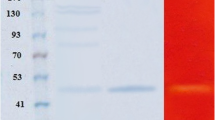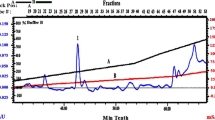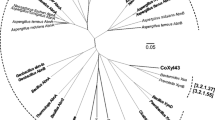Abstract
Alkalophilic Cellulosimicrobium cellulans CKMX1 isolated from mushroom compost is first report on actinomycetes that has the ability to produce thermostable cellulase-free xylanase, which is an important industrial enzyme used in the pulp and paper industry. Strain CKMX1 was characterized by metabolic fingerprinting, whole-cell fatty acids methyl ester analysis and 16Sr DNA and found to be C. cellulans CKMX1.The enzyme was purified by gel permeation and anion exchange chromatography and had a molecular mass of 29 kDa. Xylanase activity was optimum at pH 8.0 and 55 °C. The enzyme was somewhat thermostable, retaining 50 % of the original activity after incubation at 50 °C for 30 min. The xylanase had K m and V max values of 2.64 mg/ml and 2,000 µmol/min/mg protein in oat spelt xylan, respectively. All metal ions except HgCl2, CoCl2 as well as CdCl2 were well tolerated and did not adversely affect xylanase activity. The deduced internal amino acid sequence of C. cellulans CKMX1 xylanase by matrix assisted laser desorption ionization-time of flight mass spectrometry resembled the sequence of β-1,4-endoxylanase, which is a member of glycoside hydrolase family 11. Some of the novel characteristics that make this enzyme potentially effective in xylan biodegradation could be useful for pulp and paper biobleaching are discussed in this manuscript.






Similar content being viewed by others
References
Altschul SF, Thomas LM, Alejandro AS, Jinghui Z, Zheng Z, Webb M, David JL (1997) Gapped BLAST and PSIBLAST: a new generation of protein database search programs. Nucleic Acids Res 25:3389–3402
Archana A, Satyanarayana T (2003) Purification and characterization of a cellulase-free xylanase of a moderate thermophile Bacillus licheniformis A99. World J Microbiol Biotechnol 19:53–57
Bataillon M, Cardinali APN, Duchiron F (1998) Production of xylanase from a newly isolated alkalophilic thermophilic Bacillus sp. Biotechnol Lett 20:1067–1071
Bataillon M, Cardinali APN, Castillon N, Duchiron F (2000) Purification and characterization of a moderately thermostable xylanase from Bacillus sp. strain SPS-0. Enzyme Microb Technol 26:187–192
Beg QK, Bhushan B, Kapoor M, Hoondal GS (2000) Enhanced production of a thermostable xylanase from xylanase from Streptomyces sp. QG-11-3 and its application in biobleaching of eucalyptus kraft pulp. Enzyme Microb Technol 27:459–466
Berens S, Kaspari H, Klemme JH (1996) Purification and characterization of two different xylanases from the thermophilic actinomycete Microtetraspora flexuosa SIIX. Antonie Van Leeuwenhoek 69:235–241
Chen S, Qu Y, Liu X (2000) Purification and properties of alkaline xylanase from Bacillus pumilus A-30. Chin J Biochem Mol Biol 17(3):224–229
Chen S, Kaufman MG, Miazgowiczand KL, Bagdasarian M, Walker ED (2013) Molecular characterization of a cold-active recombinant xylanase from Flavobacterium johnsoniae and its applicability in xylan hydrolysis. Bioresour Technol 128:145–155
Collins T, Meuwis MA, Stals I, Claeyssens M, Feller G, Gerday C (2002) A novel family 8 xylanase, functional and physicochemical characterization. J Biol Chem 277:35133–35139
Collins T, Gerday C, Feller G (2005) Xylanases, xylanase families and extremophilic xylanases. FEMS Microbiol Rev 29:3–23
Corpet F (1988) Multiple sequence alignment with hierarchial clustering. Nucleic Acids Res 16:10881–10890
George SP, Ahmad A, Rao MB (2001) Studies on carboxymethyl cellulase produced by an alkalothermophilic actinomycete. Bioresour Technol 78:221–224
Henrissat B (1991) A classification of glycosyl hydrolases based on amino-acid sequence similarities. Biochem J 280:309–316
Higgins D, Thompson J, Gibson T, Thompson JD, Higgins DG, Gibson TJ (1994) CLUSTAL W: improving the sensitivity of progressive multiple sequence alignment through sequence weighting, position-specific gap penalties and weight matrix choice. Nucleic Acids Res 22:4673–4680
Inagaki K, Nakahira K, Mukai K, Tamura T, Tanaka H (1998) Gene cloning and characterization of an acidic xylanase from Acidobacterium capsulatum. Biosci Biotechnol Biochem 62:1061–1067
Keskar SS (1992) High activity xylanase from thermotolerant Streptomyces T7: cultural conditions and enzyme properties. Biotechnol Lett 14:481–486
Khandeparkar R, Bhosle N (2006a) Isolation, purification and characterization of the xylanase produced by Arthrobacter sp. MTCC 5214 when grown in solid state fermentation. Enzyme Microb Technol 39:732–742
Khandeparkar R, Bhosle N (2006b) Purification and characterization of thermoalkalophilic xylanase isolated from the Enterobacter sp. MTCC 5112. Res Microbiol 157:315–325
Khasin A, Alchanati I, Shoham Y (1993) Purification and characterization of a thermostable xylanase from Bacillus stearothermophilus T-6. Appl Environ Microbiol 59:1725–1730
Kim DY, Ham S-J, Kim HJ, Kim J, Lee M-H, Cho H-Y, Shin D-H, Rhee YH, Son K-H, Park H-Y (2012) Novel modular endo-β-1,4-xylanase with transglycosylation activity from Cellulosimicrobium sp. strain HY-13 that is homologous to inverting GH family 6 enzymes. Bioresour Technol 107:25–32
Knob A, Terrasan C, Carmona E (2010) β-Xylosidases from filamentous fungi: an overview. World J Microbiol Biotechnol 26:389–407
Kubata KB, Horitsu H, Kawai K, Takamizawa K, Suzuki T (1992) Xylanase of Aeromonas caviae ME-I isolated from the intestine of a herbivorous insect (Samia cynthia pryeri). Biosci Biotechnol Biochem 56:1463–1464
Leskinen S, Mantyla A, Fagerstrom R, Vehmaanpera J, Lantto R, Paloheimo M (2005) Thermostable xylanases, Xyn10A and Xyn11A, from the actinomycete Nonomuraea flexuosa: isolation of the genes and characterization of recombinant Xyn11A polypeptides produced in Trichoderma reesei. Appl Microbiol Biotechnol 67:495–505
Li X, She Y, Sun B, Song H, Zhu Y, Lv Y, Song H (2010) Purification and characterization of a cellulase-free, thermostable xylanase from Streptomyces rameus L2001 and its biobleaching effect on wheat straw pulp. Biochem Eng J 52:71–78
Lu F, Lu M, Lu Z, Bei X, Zhao H, Wang Y (2008) Purification and characterization of xylanase from Asprgillus ficuum AF-98. Bioresour Technol 99:5938–5941
Mamo G, Hatti-Kaul R, Mattiasson B (2006) A thermostable alkaline active endo-β-1-4-xylanase from Bacillus halodurans S7: purification and characterization. Enzyme Microb Technol 39:1492–1498
Matsuoka S, Yukawa H, Inmi M, Doi RH (2007) Synergistic interaction of Clostridium cellulovorans cellulosomal cellulase and HbpA. J Bacteriol 189:7190–7194
Miller GL (1959) Use of dinitrosalicylic acid reagent for determination of reducing sugars. Anal Biochem 31:426–428
Nakamura S, Wakabayashi K, Nakai R, Aono R, Horikoshi K (1993) Purification and some properties of an alkaline xylanase from alkaliphilic Bacillus sp. strain 41M-1. Appl Environ Microbiol 59:2311–2316
Page RDM (1996) TREEVIEW: an application to display phylogenetic trees on personal computers. Comput Appl Biosci 12:357–358
Panbangred W, Shinmyp A, Kinoshita S, Okada H (1993) Purification and properties of endoxylanase produced by Bacillus pumilus. Agric Biol Chem 47:957–963
Sambrook J, Russel DW (2001) Molecular cloning: a laboratory manual. Cold spring Harbor Laboratory, New York
Sanchez-Porro C, Martin S, Mellado E, Ventosa A (2003) Diversity of moderately halophilic bacteria producing extracellular hydrolytic enzymes. J Appl Microbiol 94:295–300
Sasser M (1990) Technical note 102. Tracking a strain using the Microbial Identification System. MIS, Newark
Sasser M, Wichman MD (1991) Identification of microorganisms through use of gas chromatography and high-performance liquid chromatography. In: Balows A, Hausler WJ Jr, Herrman KL, Isenberg HD, Shadomy HJ (eds) Manual of clinical microbiology, 5th edn. American Society for Microbiology, Washington
Shi QQ, Sun J, Yu HL, Li CX, Bao J, Xu JH (2011) Catalytic performance of corn stover hydrolysis by a new isolate Penicillium sp. ECU0913 producing both cellulase and xylanase. Appl Biochem Biotechnol 164:816–830
Sneath PHA (1994) Endospore forming gram positive rods and cocci. In: Hensyl WM (ed) Bergey’s manual of systematic bacteriology, 9th edn. Williams and Wilkins, Philadelphia
Sriyapai T, Somyoonsap P, Matsui K, Kawai F, Chansiri K (2011) Cloning of a thermostable xylanase from Actinomadura sp. S14 and its expression in Escherichia coli and Pichia pastoris. J Biosci Bioeng 111:528–536
Subramaniyan S (2012) Isolation and characterisation of low molecular weight xylanase from Bacillus pumilus SSP-34. Appl Biochem Biotechnol 166:1831–1842
Subramaniyan S, Prema P (2002) Biotechnology of microbial xylanases: enzymology, molecular biology, and application. Degradation of xylan to d-xylose by recombinant Saccharomyces cerevisiae coexpressing the Aspergillus niger beta-xylosidase (xlnD) and the Trichoderma reesei xylanase II (xyn2) genes. Crit Rev Biotechnol 22:33–64
Teather RM, Wood PJ (1982) Use of Congo red-polysaccharide interactions in enumeration and characterization of cellulolytic bacteria from the bovine rumen. Appl Environ Microbiol 43:777–780
Tsenga MJ, Yap MN, Ratanakhanokchai K, Kyu KL, Chen ST (2002) Purification and characterization of two cellulase-free xylanases from an alkaliphilic Bacillus firmus. Enzyme Microb Technol 30:590–595
van Zyl WH, La Grange DC, Pretorius IS, Claeyssens M (2001) Degradation of xylan to d-xylose by recombinant Saccharomyces cerevisiae coexpressing the Aspergillus niger-Xylosidase (xlnD) and the Trichoderma reesei xylanase II (xyn2) genes. Appl Environ Microbiol 67:5512–5519
Viikari L, Kantelinen A, Sundquist J, Linko M (1994) Xylanases in bleaching: from an idea to the industry. FEMS Microbiol Rev 13:335–350
Waino M, Ingvorsen K (2003) Production of β-xylanase and β-xylosidase by the extremely halophilic archaeon Halorhabdus utahensis. Extremophiles 7:87–93
Walia A, Mehta P, Chauhan A, Shirkot CK (2012a) Production of alkalophilic xylanases by Paenibacillus polymyxa CKWX1 isolated from decomposing wood. Proc Natl Acad Sci India Sect B Biol Sci 83(2):215–223
Walia A, Mehta P, Chauhan A, Shirkot CK (2012b) Optimization of cellulase-free xylanase production by alkalophilic Cellulosimicrobium sp. CKMX1 in solid-state fermentation of apple pomace using central composite design and response surface methodology. Ann Microbiol 63:187–198
Wejse PL, Ingvorsen K, Mortensen KK (2003) Purification and characterization of two extremely halotolerant xylanases from a novel halophilic bacterium. Extremophiles 7:423–431
Wong KKY, Tan LUL, Saddler JN (1988) Multiplicity of β-1,4 xylanase in microorganisms: functions and applications. Microbiol Rev 52:305–317
Zhang Q, Zou H, Guo Z, Zhang Q, Chen X, Ni J (2001) Matrix-assisted laser desorption/ionization mass spectrometry using porous silicon and silica gel as matrix. Rapid Commun Mass Spectrom 15:217–223
Zhou J, Shi P, Zhang R, Huang H, Meng K, Yang P (2010) Symbiotic Streptomyces sp. TN119 GH 11 xylanase: a new pH-stable, protease- and SDS-resistant xylanase. J Ind Microbiol Biotechnol 38:523–530
Acknowledgments
We thank Department of Science and Technology, Ministry of Science and Technology, Govt. of India, for providing contingency grant through Inspire Fellowship.
Author information
Authors and Affiliations
Corresponding author
Rights and permissions
About this article
Cite this article
Walia, A., Mehta, P., Chauhan, A. et al. Purification and characterization of cellulase-free low molecular weight endo β-1,4 xylanase from an alkalophilic Cellulosimicrobium cellulans CKMX1 isolated from mushroom compost. World J Microbiol Biotechnol 30, 2597–2608 (2014). https://doi.org/10.1007/s11274-014-1683-3
Received:
Accepted:
Published:
Issue Date:
DOI: https://doi.org/10.1007/s11274-014-1683-3




